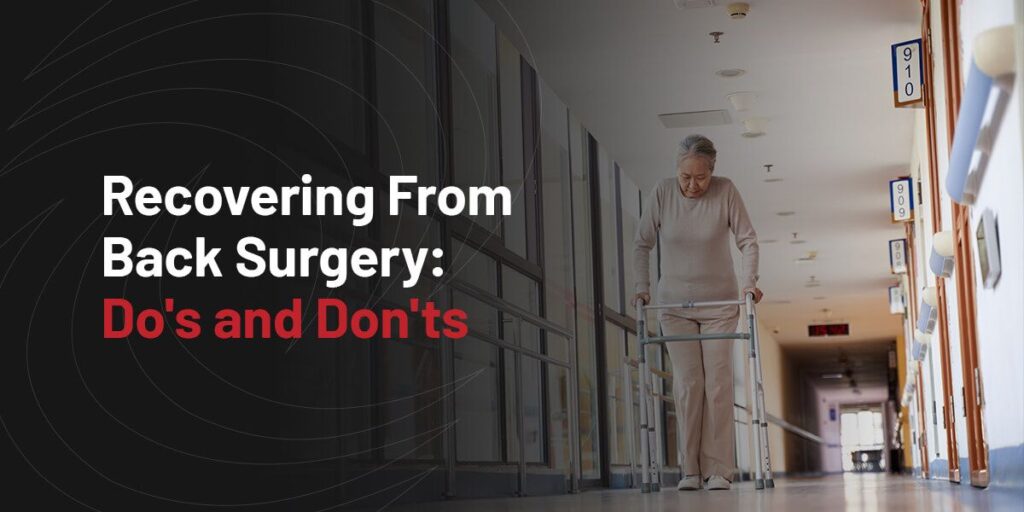
Recovering from surgery is an important opportunity to care for yourself as your body heals. Following back surgery, you will need to regain mobility, muscle strength, flexibility, and range of motion. Following some essential post-surgery do’s and don’ts can help you reach your recovery goals and heal safely.
Continue reading to learn more about what you should and shouldn’t do during spine surgery recovery.
The time it takes to recover from back surgery depends on the type of surgery you receive. For example, you may recover within a few weeks following a discectomy, but a laminectomy and fusion typically take three to four months to a full year to heal.
Following a spinal fusion, you may need to take four to six weeks off work if you are healthy and young, but you may require four to six months off if you are older or have a more strenuous job. Your overall health and degree of symptoms before surgery can also shorten or lengthen your estimated recovery time.
Back surgery requires some time, attention, care and physical therapy to ensure safe and effective healing. To achieve the best results, consider the following back surgery recovery tips:
Resting immediately after surgery supports your body’s natural healing process. Give yourself time to rest after back surgery, and avoid doing any strenuous activity that could cause injury or hinder your healing. Follow your care provider’s instructions about how long to rest and when you can resume physical activity or normal tasks.
A high fever is a sign of infection. A normal body temperature is typically between 97 and 99 degrees Fahrenheit, and a temperature of 103 degrees Fahrenheit or greater is considered a significant fever. Check your temperature regularly after surgery. If it rises above your normal temperature, you may have an infection.
Post-surgery pain and discomfort are normal, but should not worsen. Swelling and pain around your incision should gradually decrease as you heal, and persistent pain can indicate infection. Contact your medical provider if you feel any sharp or shooting pain.
Your incision may be warm, tender and red following surgery. However, red streaks or blotches can indicate infection. Contact your medical team if you notice any red streaks around your incision or spreading from your incision.
Coughing, trouble breathing and chest pain are also signs of an infection. If you notice any of these signs, contact your care provider as soon as possible.
Your incision should stop draining a few days following surgery. If drainage persists or you notice a discharge with a foul odor, abnormal color, or excessive bleeding, you may have an infection.
Physical therapy is crucial to the spine surgery recovery process. Post-surgery physical therapy has the following benefits:
Physical therapy also helps patients learn how to move safely so they can perform daily tasks without injury. Commit to physical therapy and follow your physical therapist’s instructions to achieve a successful recovery, build your strength and regain your mobility.
When your doctor approves exercise, try to move regularly. Light exercise increases blood circulation, which can accelerate the recovery process. Movement also heats joint fluid to lubricate your joints and ease discomfort. Try to incorporate at least one of the following exercises into your daily post-spinal surgery routine:
Several pain management options can help you feel more comfortable following back surgery. As your body recovers, you may feel some pain or discomfort until your spine stabilizes. You can try the following pain management techniques to find relief:
While resting immediately after back surgery is important, try to maintain a healthy balance between rest and physical activity. Your doctor will tell you when you can start resuming your normal activities following surgery. Avoid lying in bed or on the couch all day and try to move around when it is safe to do so.
Walk around your house or complete some simple self-care tasks. It’s important to sufficiently stimulate your spine-supporting muscles to ease the stress on your spine. Lying on the couch all day can weaken your back muscles and make you feel stiff.
If you’re eager to return to your pre-surgery physical activity, remind yourself that recovery takes time. Avoid overdoing movement and exercise, and remember to pace yourself. After surgery, it’s important to listen to your body and slow down if you feel worsening pain.
Medication can help relieve your pain following surgery, but avoid relying solely on your medication. It’s a convenient pain relief option often prescribed after back surgery, but too much can become addictive if a patient develops a tolerance to the medication. You can communicate with your doctor about your pain levels and desired level of pain relief.
While you should avoid relying solely on medication following surgery, it’s still important to take the necessary medication if your doctor prescribes it. Some medications can reduce the risk of infection, and managing your pain safely can make physical therapy easier and more comfortable for you.
If you are worried about becoming dependent on a certain type of pain medication, talk to your doctor about your options and the discomfort level you can tolerate. Your care provider can also help you develop a transition plan to help you taper your medications as you recover.
Your doctor cares about your surgery outcome and wants you to heal safely and successfully. Contact your doctor if you have any questions or concerns so they can help you reach your recovery goals. It’s also important to contact your doctor as soon as possible if you notice any signs of a possible infection so they can provide the proper care.
Following the proper do’s and don’ts following spine surgery can help you achieve positive results, heal faster and reach your recovery goals. Desert Institute for Spine Care is a leader in minimally invasive spine care, and we offer innovative surgical options for back and neck pain. Contact us to learn more about how we can help you relieve pain and feel younger.